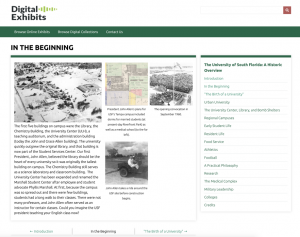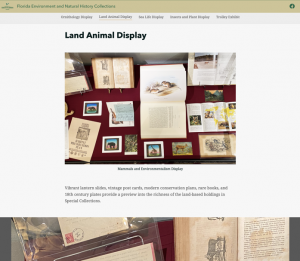Guest Post from Dr. Amanda Boczar, the Operations Manager for Tampa Special Collections. Amanda is a historian who specializes in digital humanities and digital pedagogy.
As we all navigate through a world with more online meetings, learning, and events than ever before, finding a way to express our thoughts visually has presented new challenges and opportunities. There are a lot of exciting ways to incorporate exhibits and webpages into your classes or Digital Humanities projects, whether you’re using your own photos, items from Digital Collections, or research collected during your last visit to Special Collections. USF Libraries subscribes to two of the leading platforms for creating exhibit content, Omeka and ArcGIS StoryMaps. Below, we’ll introduce both of those platforms along with other open source and subscription-based platforms available to USF students.

Open-Source Exhibit Pages
Omeka is a leader for online exhibits. This open-source platform offers both a free and subscription option. USF Libraries recently updated all of our Omeka exhibits to take advantage of new features. This easy-to-use system offers a great option if you want to share a lot of information about the items in your exhibit, as all photos can include detailed metadata. This “Historic Overview” of USF has some great images of USF through time!
Other free and open-source platforms that you might try include CollectiveAccess, CollectionsSpace, OpenExhibits. The Kress Collection from the National Gallery of Art is a great example of a collection hosted through CollectiveAccess. It provides a beautiful layout for different types of digital copies of documents and art.

ArcGIS Online
Beyond open source, there are other tools you can access as part of the USF community! As a USF faculty member or student, you also have access to the subscription-based service ArcGIS Online, including their StoryMaps software. StoryMaps is an easy-to-use webpage layout which works great for simple exhibits. Users can integrate maps and GIS projects developed in ArcGIS Online to get even more from the software. If you’re new to StoryMap exhibits, check out USF Libraries Tampa Special Collections recent History of the Book course or the guide to our LGBTQ+ Book and Archives Collections!
The Digital Heritage and Humanities Collections (DHHC) team at the USF Libraries administers ArcGIS Online, and has created this helpful getting started guide.
Other Exhibit and Website Builders
Through your Microsoft account with USF, you can also access Microsoft Sway. Sway is very visually driven and great for photo projects. Some other free options that you might use include the basic versions of Google Sites, WordPress, or Wix. These blog and website layout programs offer snappy templates and easy design options for lots of different exhibit projects.
Using these builder tools, you can embed interactive plug-ins to add depth and dimension to your presentations! Timeline.js, allows you to easily build interactive timelines. These might include images, captions, and links to other interactive content. Sketchfab offers 3D models for exploration. The DHHC at USF has a wide variety of models available for use. Other analysis tools like Voyant and TableauPublic also allow for embedding into these tools, providing endless options for engaging charts.